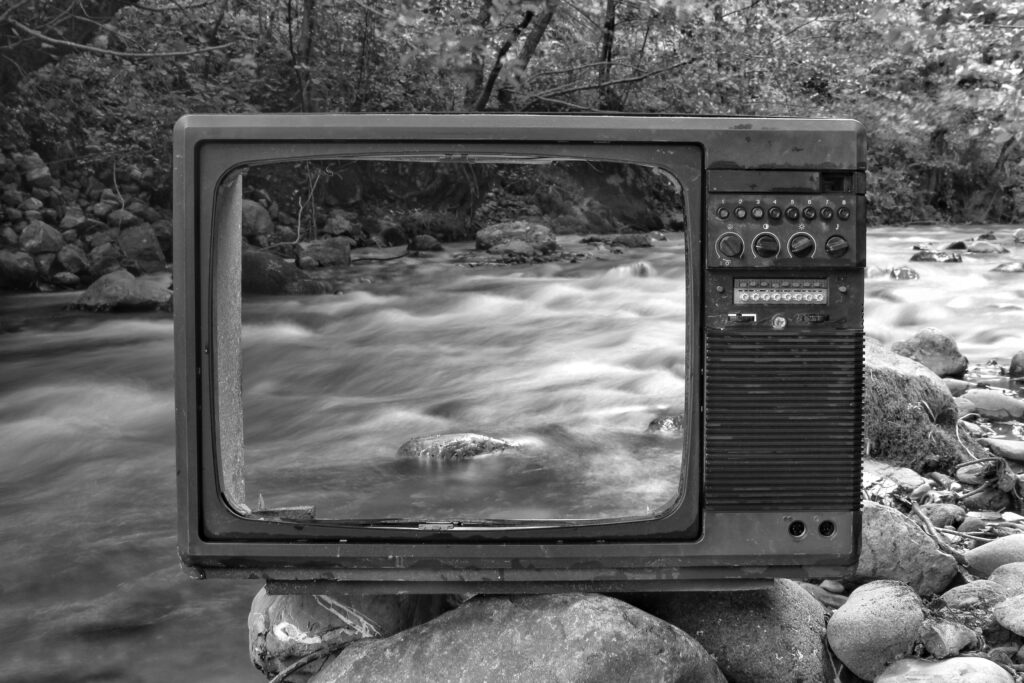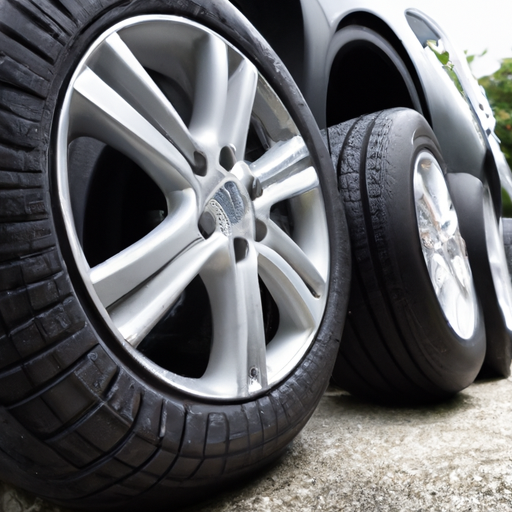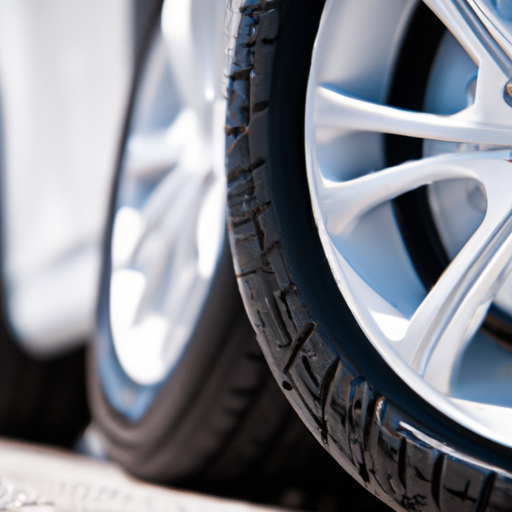Are you wondering how to safeguard your tires from UV damage? As the sun’s rays can cause harm to your tires, it’s essential to take proactive measures to protect them. UV damage can lead to tire sidewall cracking, discoloration, and decreased tire lifespan. By implementing a few simple strategies, such as parking in shaded areas, applying tire protectants, and regular inspections, you can shield your tires from UV damage and ensure their longevity.
Understanding UV Damage to Tires
When it comes to taking care of your vehicle, it’s important not to overlook the wellbeing of your tires. UV rays, the same harmful rays that can damage your skin, can also wreak havoc on your tires. Understanding the effects of UV rays on tires is essential in order to properly protect and maintain them.
The effects of UV rays on tires
UV rays can cause significant damage to tires over time. The rubber compounds that make up the structure of your tires can deteriorate when exposed to prolonged and intense sunlight. This degradation can lead to dry rot, which weakens the tire’s structure and reduces its overall lifespan. Additionally, the sun’s rays can fade the tire’s color and make it appear dull and worn.
Common signs of UV damage
It’s important to be aware of the common signs of UV damage on tires so that you can take immediate action to prevent further deterioration. Some signs of UV damage include cracking, peeling, or flaking of the rubber surface, as well as visible discoloration or fading. If you notice any of these signs, it’s crucial to address the issue promptly to avoid compromising the safety and performance of your tires.
Importance of protecting tires from UV rays
Protecting your tires from UV rays is not only about maintaining their appearance; it’s also crucial for their overall functionality and safety. UV damage weakens the structural integrity of tires, making them more susceptible to punctures and blowouts. By properly protecting your tires from UV rays, you can extend their lifespan, ensure optimal performance, and enhance your safety on the road.
Choosing the Right Tires
One of the key aspects of protecting your tires from UV damage is choosing the right tires that offer UV protection.
UV protection features in tires
When shopping for tires, look for those that are specifically designed with UV protection features. Some tire manufacturers incorporate additional additives and compounds into the rubber to enhance UV resistance. These features can provide an extra layer of protection against the harmful effects of sunlight, helping to extend the life of your tires.
Choosing tires with higher UV resistance
Consider opting for tires with higher UV resistance if you live in an area with intense sunlight. Tires that are specifically labeled as UV-resistant are engineered to withstand prolonged exposure to UV rays. These tires are made with special compounds that are less susceptible to degradation caused by sunlight, making them an excellent choice for those seeking maximum protection against UV damage.
Considering all-season or UV-resistant tires
If UV protection is a top priority for you, consider investing in all-season or UV-resistant tires. These tires are specifically designed to withstand a wide range of weather conditions, including intense sunlight. They offer an added layer of protection against UV damage, while also providing excellent performance in various road conditions. Investing in these types of tires can provide you with peace of mind and long-lasting protection.

Proper Tire Cleaning and Maintenance
In addition to choosing the right tires, proper cleaning and maintenance are essential for protecting your tires from UV damage.
Regularly cleaning the tires
Make it a habit to regularly clean your tires to remove dirt, debris, and other contaminants that can contribute to UV damage. This not only helps in ensuring their longevity but also improves their overall appearance. Regular cleaning also allows you to inspect the tires for any signs of damage or wear.
Using mild cleaning products
When cleaning your tires, it’s important to use mild cleaning products that are specifically formulated for automotive use. Harsh chemicals and abrasives can damage the rubber surface of your tires and accelerate the UV degradation process. Opt for gentle cleaners that are specifically designed for tires to ensure that you’re effectively cleaning them without causing any harm.
Avoiding harsh chemicals and abrasives
While it may be tempting to use strong chemicals or abrasive tools to remove stubborn stains or marks on your tires, it’s important to refrain from doing so. These harsh chemicals and abrasive tools can strip away the protective compounds on the tire’s surface and leave them vulnerable to UV damage. Stick to gentle cleaning methods and avoid anything that could potentially harm your tires.
Inspecting tires for signs of damage
Regularly inspecting your tires for signs of damage is crucial in identifying and addressing any UV damage early on. Look for any signs of cracking, peeling, or discoloration. If you notice any of these signs, it’s important to consult a professional and consider replacing your tires to ensure your safety on the road.
Utilizing Tire Covers or Shades
Another effective way to protect your tires from UV damage is by utilizing tire covers or shades.
Benefits of using tire covers
Tire covers offer an additional layer of protection against UV rays, shielding your tires from direct exposure to sunlight. They can help prevent cracking, fading, and other signs of UV damage. Additionally, tire covers can also protect your tires from dirt, debris, and other environmental factors that can contribute to their deterioration.
Different types of tire covers available
When it comes to choosing tire covers, there are several options available to suit different needs and preferences. Some covers are designed to provide full coverage for the tire, while others only cover the tread area. Consider the level of protection you need and choose a cover that fits your tire size and style.
Proper installation and maintenance of tire covers
To ensure that tire covers effectively protect your tires from UV damage, it’s important to properly install and maintain them. Make sure the covers fit snugly and securely around the tires, ensuring no part of the tire is exposed. Regularly clean the covers and inspect them for any signs of wear or damage. Replace them as needed to maintain optimal protection for your tires.
Using tire shades for additional protection
In addition to tire covers, you can also consider using tire shades for added protection against UV rays. Tire shades are designed to block out sunlight and prevent direct exposure to the tires. They can be particularly useful in areas with intense sunlight or during prolonged periods of vehicle storage. Just like tire covers, tire shades should be properly installed and regularly maintained to ensure maximum effectiveness.

Parking in the Shade
Parking your vehicle in shaded areas is a simple yet effective way to protect your tires from UV damage.
Benefits of parking in shaded areas
Parking in shaded areas provides natural protection against UV rays. By avoiding direct exposure to sunlight, you can significantly reduce the risk of UV damage to your tires. Parking in shaded areas not only protects your tires but also helps in maintaining a cooler vehicle interior, minimizing the risk of heat-related damage.
Avoiding direct exposure to sunlight
When selecting a parking spot, choose locations that provide ample shade. Aim to park under trees, in covered parking structures, or in carports. By avoiding direct exposure of your vehicle to sunlight, you can protect your tires from the harmful effects of UV rays and promote their longevity.
Using parking structures or carports
If you don’t have access to naturally shaded parking areas, consider investing in a carport or utilizing parking structures when possible. These structures provide excellent protection against UV rays, as well as other environmental factors such as rain, snow, and hail. Parking in such structures can offer comprehensive protection for both your vehicle and your tires.
Using windshield visors for added shade
To provide additional shade and protection for your tires, consider using windshield visors. These visors can be easily placed on your vehicle’s windshield to block out sunlight and reduce the overall temperature inside your car. By keeping your car cooler, you can directly impact the temperature of your tires, further minimizing the risk of UV damage.
Applying Tire Protectant Products
Tire protectant products offer an added layer of defense against UV damage, helping to preserve the quality and lifespan of your tires.
Understanding tire protectant products
Tire protectant products, also known as tire dressings or conditioners, are specially formulated to nourish and protect the rubber surface of your tires. These products typically contain UV inhibitors that help shield tires from the harmful effects of sunlight. Additionally, they can provide a glossy finish, enhancing the overall appearance of your tires.
Choosing a suitable tire protectant
When selecting a tire protectant, opt for one that explicitly offers UV protection. Look for products that contain UV inhibitors or mention UV resistance on the packaging. Additionally, choose a tire protectant that is compatible with the type of tires you have, considering factors such as the tire material, size, and tread design.
Application methods for tire protectant
Proper application of tire protectant is essential for optimal results. Start by thoroughly cleaning your tires and ensuring they are dry. Apply the protectant following the manufacturer’s instructions, using a sponge, cloth, or applicator pad. Allow the protectant to fully penetrate the rubber surface and dry before driving your vehicle.
Frequency of application for maximum protection
To maintain maximum protection against UV damage, it’s important to regularly apply tire protectant. The frequency of application will depend on various factors such as weather conditions, driving habits, and the specific product you are using. As a general rule, aim to reapply the protectant every few weeks or as recommended by the manufacturer.

Maintaining Proper Tire Pressure
Maintaining proper tire pressure not only enhances your tire’s performance but also plays a role in protecting them from UV damage.
Effects of underinflation on UV damage
Underinflated tires are more susceptible to UV damage due to increased sidewall flexing. When tires are not properly inflated, they cannot fully support the weight of the vehicle, causing increased friction and heat buildup. This can accelerate the degradation process and increase the risk of damage from UV rays.
Checking tire pressure regularly
Make it a habit to check your tire pressure regularly using a tire pressure gauge. Ensure that the pressure meets the manufacturer’s recommended PSI (pounds per square inch) level. This will not only help protect your tires from UV damage but also improve fuel efficiency, tire longevity, and overall safety.
Inflating tires to the recommended PSI
Properly inflating your tires to the recommended PSI is essential for preventing UV damage. The recommended PSI can usually be found in your vehicle’s owner manual or on a sticker on the driver’s side door jamb. Be mindful of changes in temperature, as tire pressure can fluctuate with temperature variations. Adjust the tire pressure accordingly to maintain the optimal level.
Avoiding overinflation
While it’s crucial to avoid underinflation, it’s equally important to avoid overinflating your tires. Overinflated tires are more prone to damage from UV rays due to increased stiffness and reduced shock absorption. Follow the manufacturer’s recommended PSI guidelines and avoid exceeding the maximum inflation pressure indicated on the tire sidewall.
Rotating and Balancing Tires
Regular rotation and balancing of your tires are essential for maintaining even UV exposure and overall tire performance.
Importance of tire rotation and balancing
Tire rotation involves moving your tires from one position to another according to a specific pattern. This helps distribute wear evenly among all the tires, enhancing their longevity and performance. Balancing, on the other hand, ensures that the weight of the tire and wheel assembly is evenly distributed, reducing vibrations and promoting a smoother ride.
Evenly distributing UV exposure on tires
By regularly rotating your tires, you can ensure that all of them receive equal UV exposure. This helps prevent uneven degradation and allows you to address any signs of UV damage early on. Balancing the tires further enhances their overall performance and ensures that they wear evenly, regardless of the position they are in.
Scheduling regular tire rotations
Consult your vehicle’s owner manual or seek advice from a tire professional to determine the appropriate tire rotation schedule for your specific vehicle. As a general rule, it’s recommended to rotate your tires every 5,000 to 8,000 miles or as indicated by the tire manufacturer. Regular rotations will help maintain consistent UV exposure across all tires and contribute to their longevity.
Balancing tires for optimum performance
Tire balancing should be performed whenever you notice vibrations or irregular tread wear. It’s also recommended to balance the tires during each tire rotation or when installing new tires. A tire professional will use specialized equipment to distribute the weight evenly, ensuring optimal performance and reducing the risk of UV damage.

Storing Tires Properly
Proper tire storage is crucial when it comes to protecting your tires from UV damage during periods of non-use.
Proper tire storage techniques
When storing your tires, it’s important to follow proper storage techniques to prevent UV damage. Store your tires in a cool, dry, and well-ventilated area away from direct sunlight. Avoid placing them near any heat sources or chemicals that could accelerate the degradation process. Storing tires vertically or using a tire rack can also help prevent excessive pressure on the sidewalls.
Keeping tires away from direct sunlight
Direct sunlight can accelerate the UV degradation of stored tires, even when not in use. Therefore, it’s crucial to keep your tires away from direct sunlight during storage. Consider storing them in a garage, shed, or any other covered area that provides protection against sunlight. If you must store them outside, invest in tire covers or utilize shade structures to shield them from direct exposure.
Choosing suitable storage locations
Choose a storage location that meets the necessary conditions for tire preservation. A cool and dry environment is ideal, as heat and moisture can contribute to rubber deterioration. Avoid storing tires next to sources of ozone, such as electric motors, as ozone can accelerate the UV damage process. Additionally, ensure that the storage area is free from any sharp objects or chemicals that could harm the tires.
Using tire bags or covers during storage
To provide added protection during storage, consider using tire bags or covers. These protective covers are designed to shield your tires from UV rays, moisture, dust, and other external factors that can contribute to damage. When using tire bags or covers, ensure that the tires are clean and dry before installing them. This will help prevent the growth of mold or mildew during storage.
Seeking Professional Tire Care
While there are many ways you can protect your tires from UV damage on your own, seeking professional tire care can provide additional benefits.
Benefits of professional tire care
Professional tire care services have the expertise and specialized equipment to thoroughly inspect, maintain, and preserve your tires. They have in-depth knowledge about various types of tires, including those specifically designed to resist UV damage. Professional care can identify and address any issues early on, ensuring optimal performance and longevity for your tires.
Tire inspections and maintenance
Regular tire inspections by professionals can detect signs of UV damage or other tire-related problems that may not be visible to the untrained eye. They can check for cracking, peeling, uneven wear, and other indicators of UV damage. Additionally, professionals can perform necessary maintenance tasks, including tire rotation, balancing, and pressure adjustments, to maximize tire performance and lifespan.
Professional cleaning and conditioning services
Professional tire care services often offer specialized cleaning and conditioning treatments to protect your tires from UV damage. These treatments can include deep-cleaning to remove stubborn dirt and stains, as well as applying UV protectant products that offer long-lasting defense against sunlight. By utilizing these professional services, you can ensure that your tires receive the highest level of care and protection.
Seeking advice from tire experts
If you have specific concerns or questions about protecting your tires from UV damage, don’t hesitate to seek advice from tire experts. Tire professionals have extensive knowledge about the best practices and products for preserving and maintaining tires. They can provide personalized recommendations based on your specific needs and help you make informed decisions when it comes to tire care.
In conclusion, protecting your tires from UV damage is essential for maintaining their performance, longevity, and overall safety. By understanding the effects of UV rays on tires, choosing the right tires, following proper cleaning and maintenance techniques, utilizing tire covers or shades, parking in shaded areas, applying tire protectant products, maintaining proper tire pressure, rotating and balancing tires, storing tires properly, and seeking professional tire care when needed, you can effectively shield your tires from the harmful effects of UV rays. Taking these proactive measures will not only enhance the appearance of your tires but also ensure optimal performance, longevity, and safety on the road.


